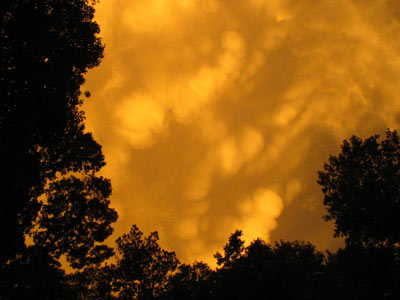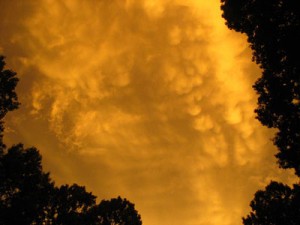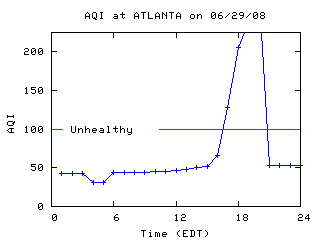Yellow Sky Over Atlanta
I had just finished writing the first draft of my post below, and a dear dear friend called me just as the wind started up. We got off the phone a little bit before 8, and the rain began. I ran out to pick up a couple of things, came back, and was just starting to have a bite to eat when John and I both noticed that the sky had turned a very eerie shade of yellow. The sun was starting to set, but I don’t remember seeing sky that color before – or seeing clouds like that either. The rain had stopped, and so had the wind, but the sky made me think of tornadoes.
Here’s what it looked like at about 8:45 or so:
It’s already June 30th now – I have to go to sleep! – but the data is for the 29th.
Everything seemed wild tonight.
| Time | 68° | humidity | Pressure | Visibility | Ceiling | Wind /td> | Weather |
| 8:52 PM | 68° | 93% | 30.03in | 10mi | 5500ft | SW-9mph | Broken Clouds |
| 8:30 PM | 66° | 94% | 30.03in | 10mi | 25000ft | SW-8mph | Broken Clouds |
| 8:06 PM | 70° | 88% | 30in | 7mi | 3600ft | N-5mph | Overcast Thunderstorm |
| 7:56 PM | 68° | 88% | 30in | 2mi | 3300ft | S-8mph, Gusts 38mph | Overcast Thunderstorm |
| 6:52 PM | 79° | 69% | 29.97in | 10mi | 4000ft | SSW-19mph, Gusts 25mph | Broken Clouds Thunderstorm |
Wow! The air quality went crazy! Look at that carbon monoxide burst! Did something happen?
Today’s AQI (Primary Pollutant) for Metropolitan Atlanta
1-8 9-16 17-24
01 43 (PM25 ) 09 44 (PM25 ) 17 128 (CO )
02 43 (PM25 ) 10 45 (PM25 ) 18 206 (CO )
03 43 (PM25 ) 11 45 (PM25 ) 19 236 (CO )
04 31 (PM25 ) 12 47 (PM25 ) 20 268 (CO )
05 31 (PM25 ) 13 48 (PM25 ) 21 53 (PM25 )
06 44 (PM25 ) 14 50 (PM25 ) 22 53 (PM25 )
07 44 (PM25 ) 15 52 (PM25 ) 23 53 (PM25 )
08 44 (PM25 ) 16 66 (CO ) 24 53 (PM25 )
Carbon Monoxide (CO) is an odorless, colorless gas that is a by-product of the incomplete burning of fuels. Industrial processes contribute to CO pollution levels, but the principal source of CO pollution in most large urban areas is the automobile. Cigarettes and other sources of incomplete burning in the indoor environment also produce CO. CO is inhaled and enters the blood stream; there it binds chemically to hemoglobin, the substance that carries oxygen to the cells, thereby reducing the amount of oxygen delivered to all tissues of the body. The percentage of hemoglobin inactivated by CO depends on the amount of air breathed, the concentration of CO in air, and length of exposure; this is indexed by the percentage of carboxyhemoglobin found in the blood.
Health effects
CO weakens the contractions of the heart, thus reducing the amount of blood pumped to various parts of the body and, therefore, the oxygen available to the muscles and various organs. In a healthy person, this effect significantly reduces the ability to perform physical exercises. In persons with chronic heart diseases, these effects can threaten the overall quality of life, since their systems are unable to compensate for the decrease in oxygen. CO pollution is also likely to cause such individuals to experience angina during exercise. Adverse effects have also been observed in individuals with heart conditions who are exposed to CO pollution in heavy freeway traffic for 1 to 2 hours or more.In addition, fetuses, young infants, pregnant women, elderly people, and individuals with anemia or emphysema are likely to be more susceptible to the effects of CO. For these individuals, the effects are more pronounced when exposure takes place at high altitude locations, where oxygen concentration is lower. CO can also affect mental function, visual activity, and alertness of healthy individuals, even at relatively low concentrations.
Air quality levels
The air quality standard for CO, which is designed to protect public health with an adequate margin of safety, is 9 parts per million, averaged over 8 hours. EPA is required to issue a public alert when CO levels reach 15 ppm, a public warning when CO levels reach 30 ppm, and a public declaration of emergency at the level of 40 ppm. The significant harm level, at which serious and widespread health effects occur to the general population, is 50 ppm of CO.–Condensed from Measuring Air Quality: The Pollutant Standards Index; Office of Air Quality Planning and Standards, US EPA; EPA 451/K-94-001; February 1994. Cited at http://www.air.dnr.state.ga.us/information/co.html.
The same site listed today’s air as healthy.
Health Advisory: The air quality is good and you can engage in outdoor physical activity without health concerns.





